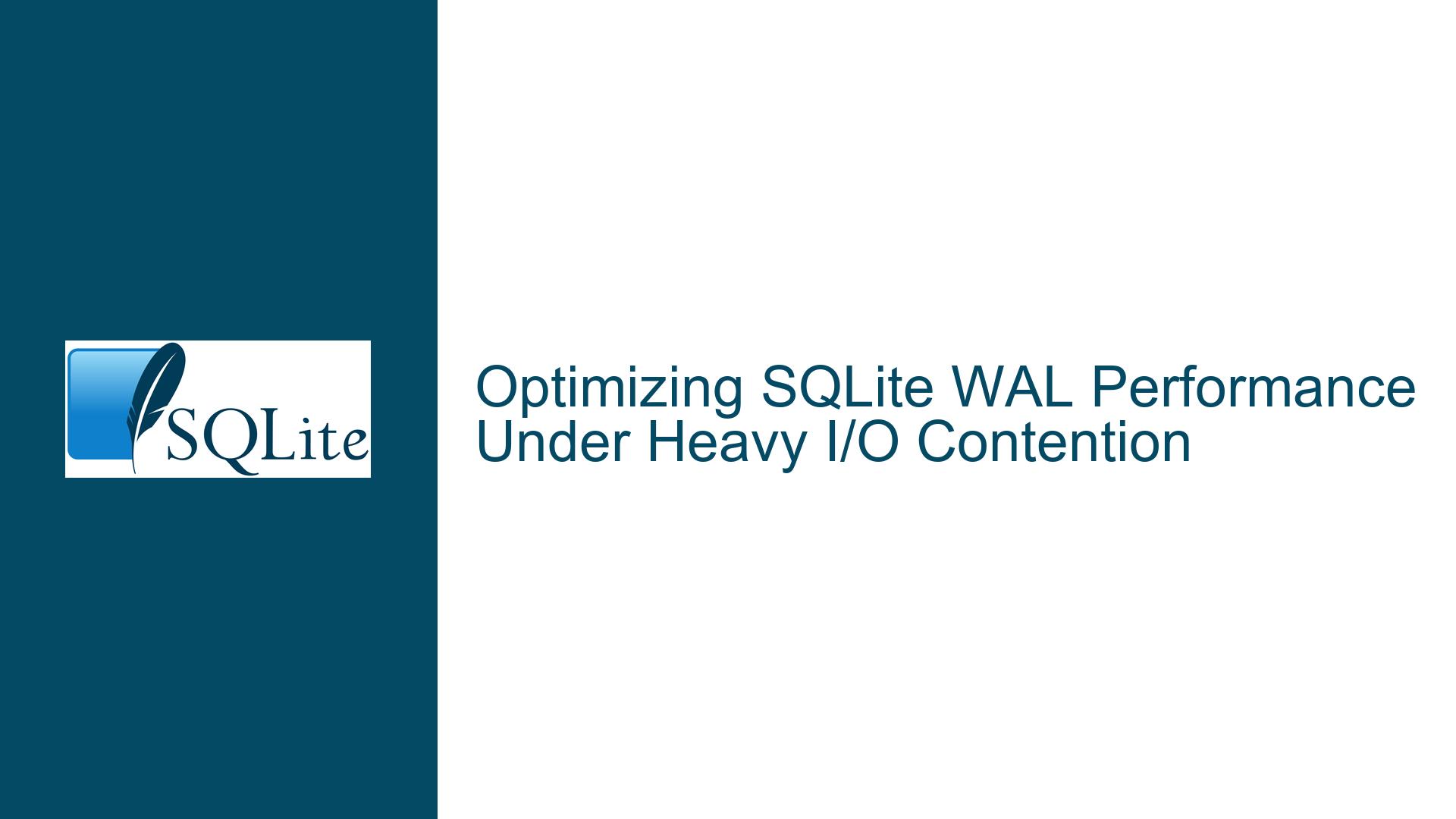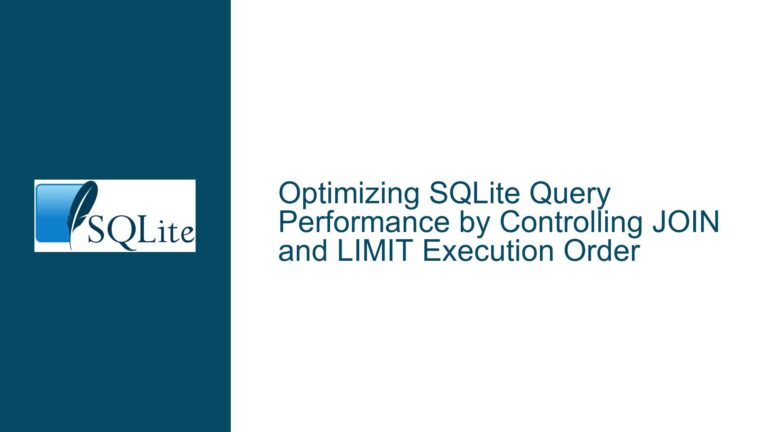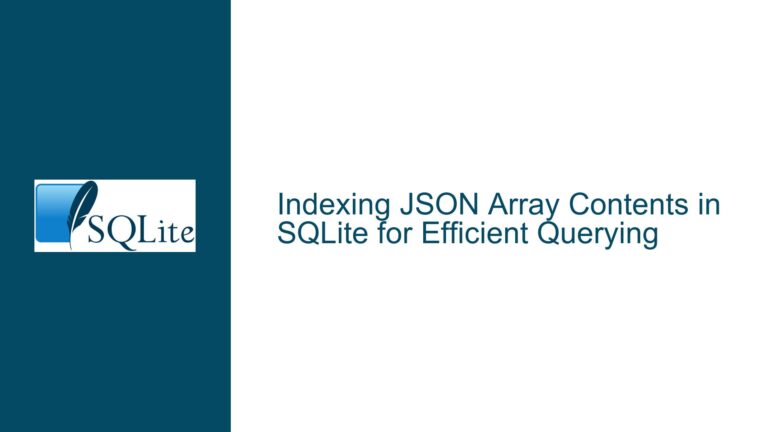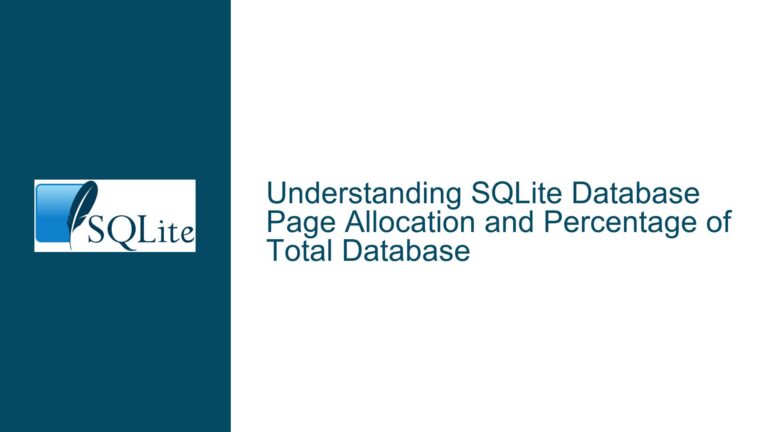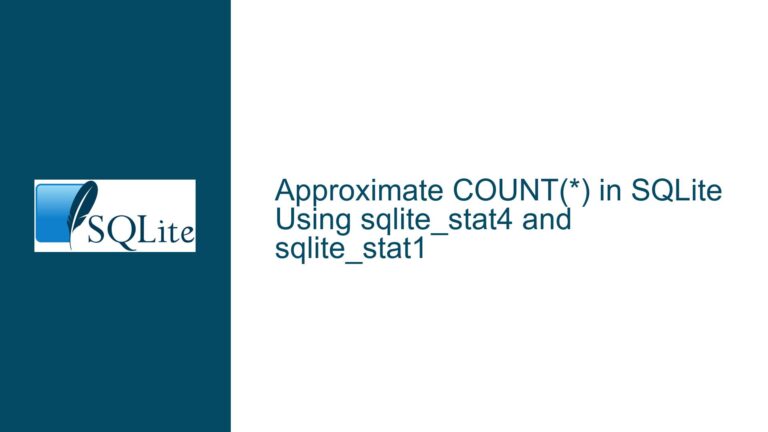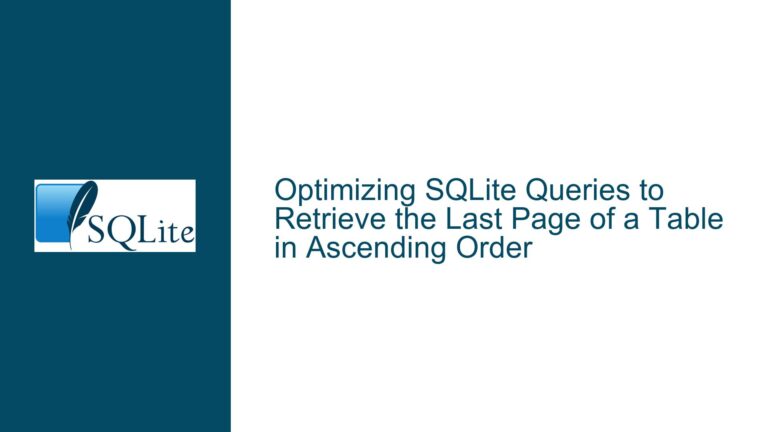Optimizing SQLite WAL Performance Under Heavy I/O Contention
Issue Overview: WAL Commit Latency and Transaction Isolation Constraints
The core challenge revolves around mitigating significant I/O bottlenecks in a high-load environment where SQLite transactions experience prohibitive write latency. The initial approach involves accumulating large transactions to defer disk I/O until storage contention subsides. However, this strategy inherently delays data visibility across processes due to SQLite’s default transaction isolation semantics. The proposal to relocate the Write-Ahead Logging (WAL) file to shared memory aims to accelerate inter-process data availability while reducing disk pressure. This intention conflicts with SQLite’s architectural constraints, particularly its reliance on serializable isolation and file-based WAL persistence.
Key technical components at play include:
- WAL Mechanism: SQLite’s WAL mode decouples transaction commits from direct database page writes by appending changes to a WAL file. Readers access unaltered database pages while writers sequentially update the WAL. The shared memory-based shm file synchronizes access to WAL metadata but does not store actual transaction data.
- Isolation Levels: Serializable isolation ensures transactions appear atomic and isolated even in concurrent access scenarios. Uncommitted WAL entries remain invisible to other connections until explicit COMMIT, regardless of WAL storage medium.
- Checkpointing Dynamics: Passive checkpoints transfer WAL contents to the main database file during reader inactivity, while active checkpoints occur when WAL size thresholds (wal_autocheckpoint) are exceeded. Manual checkpoint control introduces tradeoffs between commit latency and WAL accumulation.
- VFS Layer Abstraction: SQLite’s Virtual File System layer allows intercepting file operations, enabling theoretical redirection of WAL I/O to alternative storage mediums. However, shared memory integration demands careful synchronization beyond standard file semantics.
The central misconception lies in conflating WAL storage locality with transaction visibility. Even if WAL writes occurred entirely in shared memory, readers would still require explicit COMMIT completion to observe new data due to isolation guarantees. Performance bottlenecks stem not from WAL storage latency alone but from synchronous durability enforcement (fsync), WAL checkpointing strategies, and transaction granularity.
Possible Causes: I/O Contention, Isolation Semantics, and Checkpoint Pressure
1. Synchronous Durability Enforcement (PRAGMA synchronous)
SQLite’s default FULL synchronous mode mandates fsync operations during transaction commit to ensure crash consistency. On storage subsystems with high latency or low IOPS, these synchronous writes dominate transaction duration. Shared memory relocation avoids disk I/O but sacrifices durability unless mirrored to persistent storage—a contradiction in terms. Disabling fsync via PRAGMA synchronous=OFF risks data corruption but eliminates write stalls, illustrating a durability-performance tradeoff.
2. WAL Checkpoint Aggressiveness (PRAGMA wal_autocheckpoint)
Automatic checkpoint triggering based on WAL page count thresholds (default 1000 pages ≈4MB) forces periodic WAL truncation. Large transactions exceeding this threshold incur checkpoint overhead during commit, compounding write amplification. Manual checkpoint deferral risks uncontrolled WAL growth, exacerbating read performance degradation as WAL frames accumulate.
3. Transaction Scope and Lock Contention
Batching numerous operations into monolithic transactions maximizes atomicity but prolongs exclusive writer locks. Concurrent readers holding shared locks block checkpoint completion, creating deadlock risks. Fine-grained transactions minimize lock durations but amplify fsync overhead when synchronous= FULL/NORMAL.
4. Shared Cache Mode Limitations
Legacy shared cache mode allowed inter-process page cache visibility but suffered from deadlocks and priority inversion. Deprecation leaves processes with isolated page caches, necessitating WAL file access for cross-process visibility. Read-uncommitted isolation relaxes visibility rules but remains process-local unless paired with shared cache—an unsupported configuration.
5. VFS Shim Overhead
Interposing a custom VFS to redirect WAL I/O introduces context-switching penalties and complicates synchronization. Shared memory-backed filesystems (e.g., tmpfs) reduce disk pressure but still incur filesystem layer overhead. Pure shared memory segments require emulating file semantics (seek, truncate) via VFS shims, increasing implementation complexity.
Troubleshooting Steps, Solutions & Fixes
1. Tuning Checkpointing and Synchronous Parameters
1.1. Defer Checkpointing via wal_autocheckpoint
Increase the autocheckpoint threshold to accommodate larger WAL sizes without triggering frequent checkpoints:
PRAGMA wal_autocheckpoint = 10000; -- Allow ~40MB WAL accumulation
Monitor WAL growth via PRAGMA wal_checkpoint(TRUNCATE); during I/O quiescence. Combine with periodic manual checkpoints using sqlite3_wal_checkpoint_v2() API calls during low-load intervals.
1.2. Asynchronous Checkpointing
Use passive checkpoints to avoid blocking writers:
sqlite3_wal_checkpoint_v2(db, NULL, SQLITE_CHECKPOINT_PASSIVE, NULL, NULL);
This attempts checkpointing without acquiring write locks, retrying during subsequent calls if readers remain active.
1.3. Relax Synchronous Durability
Gradually relax durability guarantees while monitoring corruption risks:
PRAGMA synchronous = NORMAL; -- Fsync WAL only at checkpoint
PRAGMA synchronous = OFF; -- No fsync; riskier
In WAL mode, NORMAL syncs the WAL file during checkpoint, while FULL syncs both WAL and database. OFF delegates durability to the OS, which may buffer writes indefinitely.
2. Transaction Granularity and Batching
2.1. Incremental Commit Strategies
Partition large transactions into smaller batches to distribute fsync overhead:
MAX_BATCH_SIZE = 1000 # Rows per transaction
for i in range(0, total_rows, MAX_BATCH_SIZE):
with db.transaction():
insert_rows(i, i + MAX_BATCH_SIZE)
Measure batch size impact using storage subsystem latency characteristics (e.g., SSD vs HDD).
2.2. Write-Ahead Buffering with Application-Level Queues
Buffer inserts in memory, flushing to SQLite during I/O troughs. Decouple ingestion rate from database write speed using ring buffers or persistent queues (e.g., Redis, Kafka). This shifts durability responsibility upstream but introduces complexity.
3. Alternative Storage Configurations
3.1. tmpfs-Backed WAL Directory
Mount a RAM disk for WAL storage, reducing fsync latency:
mount -t tmpfs -o size=512M tmpfs /path/to/db_wal
Configure SQLite to store the WAL here:
PRAGMA journal_mode = WAL;
PRAGMA wal_file = '/path/to/db_wal/mydb.wal';
Combine with frequent checkpoints to persist changes to the main database on durable storage. Survives reboots only if WAL is checkpointed before shutdown.
3.2. Shared Memory VFS Shim
Implement a custom VFS that maps the WAL file to shared memory:
static int xWrite(sqlite3_file *file, const void *buf, int amt, sqlite3_int64 offset) {
SharedMemoryWal *shm = (SharedMemoryWal*)file;
memcpy(shm->addr + offset, buf, amt); // Copy to shared memory
return SQLITE_OK;
}
Override xSync to no-op or batch WAL flushes to disk. Requires meticulous inter-process synchronization to avoid corruption.
4. Isolation Level and Cache Sharing Workarounds
4.1. Read-Uncommitted Mode
Allow readers to view uncommitted changes within the same process:
PRAGMA read_uncommitted = 1;
Combine with shared page cache across connections:
sqlite3_config(SQLITE_CONFIG_SERIALIZED); // Enable shared cache
sqlite3_open_v2("file:db?cache=shared", &db, SQLITE_OPEN_READWRITE, NULL);
Note: Shared cache mode is deprecated and prone to deadlocks under high concurrency.
4.2. Cross-Process Notification via IPC
Use signals, sockets, or semaphores to notify readers when commits occur, prompting them to reopen connections or requery. Avoids polling but introduces coupling:
// Writer after commit
kill(reader_pid, SIGUSR1);
// Reader signal handler
void handle_sigusr1(int sig) {
sqlite3_close(db);
sqlite3_open("mydb", &db);
}
5. Alternative Database Architectures
5.1. In-Memory Databases with Periodic Snapshots
Store data entirely in shared memory:
sqlite3_open("file:memdb?mode=memory&cache=shared", &db);
Schedule periodic dumps to disk during I/O lulls:
sqlite3 memdb ".backup main disk.db"
Risk: Data loss between snapshots; best for transient or reproducible data.
5.2. Distributed Write Buffers
Offload write ingestion to a distributed log (Apache BookKeeper, NATS Streaming) with a background consumer populating SQLite. Decouples write acknowledgment from database persistence.
6. File System and Kernel Optimization
6.1. I/O Scheduler Tuning
Configure the Linux I/O scheduler for prioritized WAL flushing:
echo deadline > /sys/block/sdb/queue/scheduler
echo 1 > /sys/block/sdb/queue/iosched/fifo_batch
Assign SQLite processes to real-time scheduling classes:
struct sched_param param = { .sched_priority = 99 };
sched_setscheduler(0, SCHED_FIFO, ¶m);
6.2. File System Mount Options
Mount the database directory with noatime and data=writeback:
mount -o noatime,data=writeback /dev/sdb1 /db
Reduces metadata updates and enables write coalescing.
7. Application Architecture Reassessment
7.1. Database Sharding
Partition data across multiple SQLite databases by tenant, region, or time. Distributes I/O load but complicates querying.
7.2. Alternative Storage Engines
Evaluate embedded alternatives like RocksDB (LSM-tree) or LMDB (B+tree) that offer different write characteristics. For example, LSM-trees excel at write-heavy workloads via sequential log writes.
7.3. Ephemeral Write Caching
Accept potential data loss by buffering writes in process memory, persisting asynchronously. Requires idempotent write semantics to replay from external sources.
8. SQLite Compile-Time Customization
8.1. Disable Mutexes for Single-Process Multi-Threaded Access
Recompile SQLite with SQLITE_THREADSAFE=0 if all connections originate from a single process. Reduces lock contention overhead.
8.2. Custom WAL Implementations
Modify SQLite’s WAL handling in the amalgamation source, replacing file I/O with shared memory operations. High risk but maximum flexibility.
This comprehensive guide addresses the multifaceted nature of optimizing SQLite under severe I/O constraints, balancing durability, performance, and complexity. Each strategy presents tradeoffs requiring empirical validation against specific workload patterns and failure tolerance thresholds.
